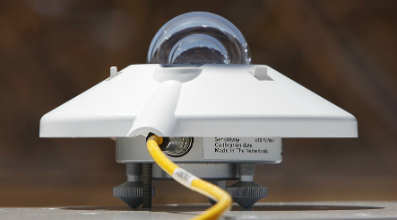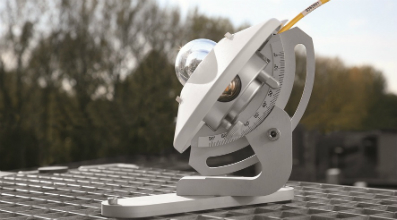High quality ground-based measurements of solar radiation are always made using radiometers with a uniform response over a wide spectral bandwidth. This is achieved using a ‘thermopile’ detector with a black coating that absorbs the incoming radiation, heats up, and converts the temperature rise into a small electrical signal. The detector is protected by a glass or quartz dome or window, the precision and quality of which affects the performance of the radiometer.
Solar radiation is ultraviolet, visible and near infrared energy in the wavelength range approximately from 300 to 3000 nanometers (nm, 10-9 m) and has three components. The global horizontal irradiance (GHI) falling onto the Earth’s surface consists of the diffuse horizontal irradiance (DHI) from the sky and the direct normal irradiance (DNI) from the sun.
GHI = DHI + DNI*cos(θ)
where θ is the solar zenith angle (vertically above the location is 0°, horizontal is 90°).
GHI is measured by a pyranometer with a hemispherical view, mounted horizontally. DHI is measured by a pyranometer shaded from the direct sun beam and DNI is measured by a pyrheliometer with a narrow view that only measures the beam directly from the sun. To measure DNI a high accuracy automatic sun tracker is required. Using the radiometer sensitivities (calibration factors) the output signals can be converted into irradiance in W/m2.
Grades of pyranometers (and pyrheliometers), their performance and calibration methods have been defined by the International Standards Organisation (ISO) in ISO 9060:1990. Instruments that comply with ISO classifications, provide accurate measurements of the solar radiation under all weather conditions.

ISO Secondary Standard thermopile pyranometer
The meteorological world and the scientific community have been using these instruments for many decades, the horizontal pyranometer measurements can be compared with present and historical data from weather and climate station networks, and from satellites; across various locations, and independent of the type of solar energy system that might be used.
PV panels have a wide field of view and must be positioned to receive the maximum amount of solar radiation throughout the year. For cost/benefit reasons panels are often installed at a fixed angle, instead of following the sun’s movement in the sky. In this case a second pyranometer should be installed at the ideal angle for that location, to measure the ‘tilted global irradiance’ with the same view as a fixed panel.
The pyranometer must have a stable, rugged mounting with which the tilt angle can be precisely set.

Rugged adjustable tilt mounting for a pyranometer
A pair of horizontal and tilted pyranometers are often used at several locations to provide year-round data on the solar energy resource. This enables the optimal locations for solar energy plants to be selected.
A similar setup is frequently used at generating sites with fixed angle panels, for reference measurements of the available energy. The pyranometer data is sent to the control room and allows the overall plant efficiency to be monitored. Pyranometer domes stay much cleaner than flat PV panels and can monitor drop-off in efficiency and the need for cleaning the panels. The latest ‘smart’ pyranometers have integrated digital interfaces for direct connection to plant data acquisition and control systems.
It is recommended to use instruments that meet, or exceed, the requirements of ISO 9060 for Secondary Standard pyranometers. If well maintained, these are capable of overall uncertainties in the solar irradiance measurement of around 2%. The only maintenance is to clean the domes and to periodically check and replace the desiccant that keeps the instruments dry internally. Recalibration is recommended every two years to maintain accuracy.